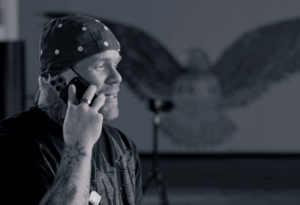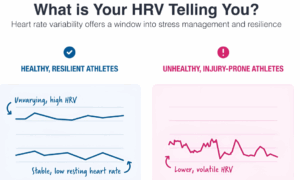A world-class MMA coach sat still in a quiet room with wires trailing from scalp sensors as his brain and heart activity were measured. Onscreen, his nervous system flickered to life – a dance of waves, spikes, and rhythms. This wasn’t a lab. This was a real-world experiment, live and unscripted. And what happened over the next 60 minutes raised serious questions – not about performance, but about protection from the things that could be interfering with our performance.
scalp sensors as his brain and heart activity were measured. Onscreen, his nervous system flickered to life – a dance of waves, spikes, and rhythms. This wasn’t a lab. This was a real-world experiment, live and unscripted. And what happened over the next 60 minutes raised serious questions – not about performance, but about protection from the things that could be interfering with our performance.
We live in a near-constant digital storm. Wi-Fi, 5G, Bluetooth, smart devices. All of them emit electromagnetic fields (EMFs) – invisible, but potent. And possibly harmful. The growing conversation around EMFs is often dominated by confusion, pseudoscience, and polarized opinions. In this moment, we found clarity, but not through opinions – this was about what the body showed us in real time.
Why This Test Mattered
We gathered to document a test of Aires, a company that’s designed next-generation EMF modulation technology. Their goal? To protect the human body from the biological stress caused by constant exposure to wireless signals.
Instead of relying on marketing claims, we wanted to see something objective. For that, we needed three things:
- A subject with elite body awareness and nervous system sensitivity
- An objective scientist with the tools and experience to decode brain and heart data
- A method that could show rapid changes in the body’s response to environmental stress
We had all three.
Dr. Nicholas Dogris: The Brain Scholar
Dr. Dogris isn’t your average lab-coated academic. He’s a clinical psychologist, neuroscientist, and EEG expert with over three decades in the field. As co-developer of NeuroField, he’s created technologies that measure and modulate brain activity to improve cognition, mood, and recovery.
But what sets Dr. Dogris apart is his ability to translate complex data into real-world meaning. When brainwaves scatter, he sees anxiety, stress, or EMF interference. When they sync, he sees potential for healing, focus, and deep recovery.
For this test, he brought his full EEG setup, tracking real-time brain activity, and pairing it with heart rate variability (HRV) monitoring. This allowed us to look not just at what Tim Welch felt, but how his body responded, under two conditions: exposed to EMFs without protection, and then again with Aires Tech introduced.
Tim Welch: Fighter and Health Afficionado
If you’re privy to the world of the UFC, there’s a fair chance you’ve heard the name Tim Welch. He’s the head coach at Red Hawk Academy and the longtime friend and coach of Sean O’Malley, the UFC’s formerly undefeated bantamweight champ known for his unique style and elite conditioning.
But what makes Tim unique isn’t just his coaching resume. It’s his approach. He’s deeply interested in holistic health, meditation, and recovery. He understands the power of the nervous system and how to use it – not just to fight, but to live well.
He’s not a biohacker. He’s a high-performance strategist. And that made him the perfect subject. His body awareness, recovery habits, and sensitivity to subtle shifts meant any changes wouldn’t go unnoticed by him or the EEG.
The Process: Wires, Data, and Stillness
We started with a baseline: Tim sat calmly while his EEG captured the natural state of his brainwaves as well as his HRV – a key marker of nervous system balance – was measured.
- HRV reading: 69.66 milliseconds
- EEG: scattered, with notable reactivity and/or tendency towards alertness and background tension
Then came the exposure phase: a smartphone placed near Tim’s head, with 5g, Wi-Fi, and Bluetooth signals active – the same kind of EMF exposure we all experience daily.
No massive changes were obvious to Tim, and that’s the tricky part with EMFs. You don’t feel them like you feel a sunburn. But your biology does respond.
Finally, we added the Aires Flex – a compact microprocessor that doesn’t block EMFs, but restructures them into more biologically coherent fields. It’s not a Faraday cage. It’s more of a tuning fork, or a filter that’s helping the body maintain order in the presence of chaos.
Within just a few minutes, the shift was measurable and statistically significant according to Dr. Dogris.
The Results: What We Saw on the Screen
After just a quarter of an hour, Tim’s HRV increased to 87.7 milliseconds – a jump of over 25%. That’s not noise. In the world of autonomic nervous system metrics, that’s huge.
What HRV Means
Heart rate variability is the time between your heartbeats. A higher HRV means your body can switch more flexibly between “fight-or-flight” (sympathetic) and “rest-and-recover” (parasympathetic). A low HRV is often seen in chronic stress, burnout, or illness. A high HRV is associated with resilience, adaptability, and well-being.
An over 25% increase in HRV in a few minutes, under controlled conditions, is a strong indicator that something helped Tim’s body shift into a recovery state.

EEG Changes
Dr. Dogris also noticed increased brainwave coherence – the signals became less scattered, with smoother rhythms suggesting a more integrated, less reactive brain state – and a shift from a baseline sympathetic activation of 55 units down to 38.
In other words, the noise quieted down.
Is This “Proof”? Let’s Talk About N of 1
This was a case study. An N of 1. That certainly doesn’t mean the data’s invalid – it just means it’s a starting point, more than a conclusion, albeit a significant one.
But here’s what really matters: the results weren’t imagined. They weren’t “felt.” They were measured by a neuroscientist with no incentive to exaggerate, using clinical-grade tools.
That’s what makes this moment important. Not because it proves Aires is the end-all be-all magic pill, but because it shows something real happened. This invites us to keep looking and take this company, one with multiple decades of research and development, seriously.
So, What Actually is Aires?
Aires Tech creates products using micropolarization and fractal resonator technology. In plain English, these are structured silicon microprocessors that modulate the shape of EMF fields, so instead of being jagged and chaotic, they become ordered and less biologically disruptive.
They don’t block EMFs – your phone still works, your Wi-Fi still streams. But your body may experience less physiological stress in their presence.
The devices are small, durable, and wearable. Think of them as EMF filters, helping your nervous system operate more efficiently in the digital age.
Behind the Camera: My Experience Witnessing It All
I actually filmed this process from start to finish. There was no script, no flashy edits, no product placement. Just science and stillness.
And I can tell you – the room changed. Tim saw it. Dr. Dogris saw it. The CEO of Aires, Josh Bruni, saw it. The data tracked it.
We weren’t there to sell a gadget. We were there to ask a question: Can technology help us protect ourselves from technology?
That day, we got a possible answer. A glimmer. A signal through the noise.
The Bigger Picture: Living Well in an EMF World

Whether you’re an athlete, entrepreneur, student, or parent, your nervous system is undeniably under siege. Not from drama or deadlines, but from electrical saturation – the always-on signals that surround us.
We can’t go back to the 1800s. But we can get smarter. More adaptive. More protective.
And if what we saw in that 60-minute test is any indication, tools like those made by Aires may help us take back a bit of our biological bandwidth.
Ready to See It For Yourself?
We’ll be releasing the full video soon – including live EEG footage, Dr. Dogris’s commentary, and Tim Welch’s reflections. Stay tuned.
In the meantime, ask better questions. Demand real data. And trust what your body is telling you.
Because in a world where stressors are chronic and invisible, your biology is speaking – if you know where to look.








